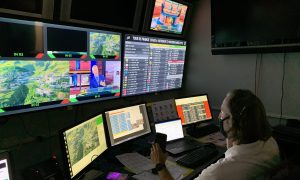Tour de France 2020: SMT Powers the Ticker From Across the Atlantic
Facility in North Carolina inserts AR, tracking and results graphics
Story Highlights
The Tour de France is under way, and the world’s best sports event for anyone with a case of unfulfilled wanderlust is being produced in a completely new way by rightsholders and their production partners around the globe.
Over the years, SMT has become a big part of NBC Sports’ Tour de France effort, which traditionally would involve three mobile units onsite: a main production unit, an edit unit, and a truck for the studio show. Those three vehicles would be part of the Tour de France circus, rolling from town to town, stage to stage.
In a typical year, Lee Brinson, director, special events, SMT, would be part of that cavalcade along with SMT staffers. SMT powers the tickers as well as any insert or key graphic that has any type of data on it.
“Whether it’s stage results, sprint results, speeds in the group, any insert graphics are ours,” says Brinson. “There is a [character generator] at NBC Sports that does more of the editorial things. We also do the iso tracking pointer on the rider.”
This year, Brinson’s forgoing the food and wine of France for home-cooked meals in North Carolina and a daily commute to the office (albeit at very unusual commuting times).
Being on the Tour itself can be a bit like Groundhog Day, says Brinson: “You wake up in your hotel, check out, figure out how to navigate the traffic, park, prep, and go through your normal day. Then you pack up the truck, get on the road, get to a new hotel, and start the whole thing over again.”
COVID-19 has changed that (although it still can feel like Groundhog Day). This year, NBC has only a satellite truck, traveling from finish line to finish line to send video to Stamford, CT. All of the augmented reality and tracking graphics are inserted at SMT’s broadcast facility in Durham, NC.
“We are connected to NBC in Stamford via the internet,” Brinson explains. “Basically, NBC receives their video, patches that up, and sends it down to us.”
What’s interesting, he adds, is that the SMT machines are physically in Stamford and the operators are in Durham. “Over the internet, we get our KVMs to our machines so we can control them. We also get all the returns so we can tie everything to the broadcast.”
Data comes in directly from TVData, a Belgian company that has provided all the data for the Tour de France for a number of years. The results and peloton data are delivered to viewers, and the dimension data, for things like real-time gradient and speed, is integrated separately.
“The group data goes directly from the TVData truck at the finish line to Durham,” says Brinson, “and we pipe it up to Stamford and our machines.”
One of the challenges is bringing together multiple pieces of data from multiple providers and combining them into one.
Historically, operations on the Tour de France are a fairly tight affair in terms of spacing. But this year, says Brinson, two SMT production staffers are located in a space that normally holds upwards of 16 people. And the challenge for the team back home is that they can’t just look and easily see what the producer and director are looking at.
“You really have to follow them and listen to their voice to know where they are going, and then you also need to pay attention to the announcers,” says Brinson. “It’s about knowing where they are going and anticipating what they’re going to talk about. Hopefully, we have the same reaction time that we would if we were there in person.”
That need to listen is all the more important because it isn’t possible to have access to 20 video feeds that are available at a glance in the production truck on the Tour.
The Tour de France is part of a super-busy slate of activity for the SMT Durham facility (as well as its Jacksonville, FL, operation). The company is still doing NASCAR and also did the Kentucky Derby, NHL playoffs, and football.
“The Tour de France is such a unique race because there are so many different competitions within the race itself,” adds Brinson. “We can take the data and isolate each one of those races in a way that the common fan can know what is happening. There’s the King of the Mountain race and a sprint race and a young-rider race. And we can explain that all with data.”

